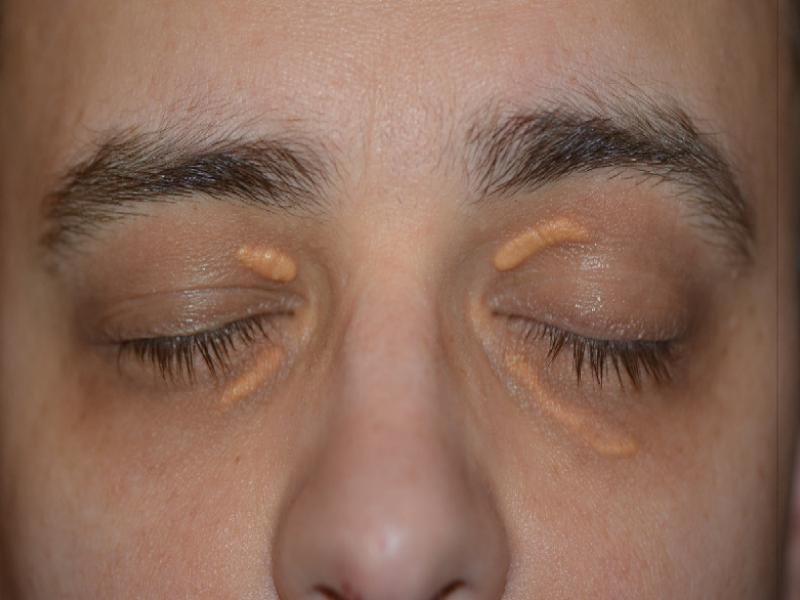Xanthelasma is a dermal anomaly that appears as yellow patches of fat on the eyelid or in the eye area. Their presence generally indicates hypercholesterolemia. Fortunately, there are several effective treatment options available for xanthelasma removal in Turkey.
We're Here to Help.

- People with cholesterol deposits under the skin around the eyes, causing yellow or whitish spots
- Scars
- Bleeding
- Infections
- Loss of skin pigmentation
- It all depends on the type of treatment chosen and the severity of the condition
Xanthelasma: What is it?
Xanthelasma palpebrarum (XP) is a benign inflammatory lesion caused by high levels of cholesterol in the blood. This accumulation of lipids often takes a yellow color in the form of large particles, and differs in degree of color and size from one person to another. It should be noted that this condition is more common in women than in men. Xanthelasma palpebrarum (XP),is harmless, but in rare cases, it can be an indicator of various heart conditions. Indeed, it can be combined with chronic diseases such as diabetes and thyroid problems.
Causes of Xanthelasma palpebrarum
Xanthelasma's appearance may be due to genetic predisposition, as it can reveal several factors that include:
- High blood pressure
- Obesity
- Cirrhosis of the liver
- Primary biliary cirrhosis
Indeed, the appearance of these lesions before the age of 40 is highly suspicious for familial hypercholesterolemia and dyslipidemia. Both diseases are characterized by high levels of lipids in the blood, which usually concern high amounts of triglycerides, cholesterol, and LDL (low-density lipoproteins).
These are a risk factor not only for atherosclerosis but also, for vascular diseases such as coronary heart disease. High levels of LDL, low levels of HDL in the blood, or familial hypercholesterolemia can lead to the formation of xanthelasmas on the eyelids.
Xanthelasmas do not cause itching or pain in the eyelids and therefore do not cause ocular symptoms.
Diagnosis of the disease
The diagnosis of xanthelasma in Turkey is clinical. If you observe certain spots on the eyelids or around the eyes, it is important to contact your ophthalmologist to understand the cause.
Xanthelasma typically manifests as soft yellowish lesions that are both flat and raised and are most often located on the medial canthus.
Doctors make the diagnosis purely visually, by examining the skin around the eyes, and then performing certain tests, including lipid profile (to check lipid levels in the body). Thus, lipid panel measurement reveals cholesterol amount and triglycerides through a blood test as it aims to distinguish between good and bad cholesterol. So it facilitates the xanthelasma palpebrarum (XP) diagnosis.
Xanthelasma Treatments in Turkey
Surgeons perform xanthelasma removal, at our partner clinics in Turkey, through several treatments. The main options are as follows:
Surgical removal
Xanthelasma treatment involves the surgical removal of lipid deposits. This excision technique is usually used for very hard and deep lesions, i.e. larger than 3 mm.
This procedure is usually performed under local anesthesia and on an outpatient basis (without hospitalization). The oculoplastic surgeon gently removes the skin patches and uses sutures to close the area.
Surgical removal greatly reduces the risk of recurrence months or years later. If surgical removal is preferred, an upper blepharoplasty with simultaneous palpebral reshaping is usually suggested. In this case, there is no need to be afraid of visible scars. On the contrary, the result is always natural and harmonious.
CO2 ablative laser treatment
If you are looking for a non-invasive method, the CO2 laser is highly recommended. The CO2 laser treatment acts on the surface of the skin thanks to a light beam that pulverizes the xanthelasma without damaging the surrounding tissue. Anesthesia is not required, but an anesthetic cream must be applied before the procedure. The lesion heals quickly and without scarring.
Regardless of the size, location, or cause of the xanthelasma, it is important to consult a physician specializing in aesthetic medicine or dermatology, who will be able to recommend the best method.
In conclusion, xanthelasma is an unsightly but treatable skin condition. If you are concerned about the appearance of patches around your eyelids, consult your physician to discuss the most appropriate treatment options for you.
Share this page
Xanthelasma can potentially reappear even after treatment, especially if the underlying cause, such as high cholesterol, is not adequately addressed. Lifestyle modifications, including a healthy diet and exercise, can help prevent recurrence.
The appearance of xanthelasma is strongly associated with a diet rich in fat, so after its removal, it may reappear if the patient does not follow a diet low in triglycerides and cholesterol.
No, xanthelasma palpebrarum can't disappear on its own, on the contrary, it can grow in size, which can be embarrassing for anyone, especially when it comes to physical appearance. So it's best to consult a dermatologist for treatment.
Yes, the appearance of xanthelasma should never be overlooked as it is often associated with an increased risk of cardiovascular disease. So it's so important to visit a doctor to evaluate your lipid panel and undergo the appropriate treatment.
